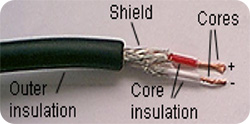Balanced Audio
Posted on March 5, 2016 by KVMGalore | 0 comments
 Balanced audio is a method of interconnecting audio equipment using impedance balanced lines. This type of connection is very important in sound recording and production because it allows for the use of long cables while reducing susceptibility to external noise.
Balanced audio is a method of interconnecting audio equipment using impedance balanced lines. This type of connection is very important in sound recording and production because it allows for the use of long cables while reducing susceptibility to external noise.
Balanced audio uses a cable made up of two conductors for the audio signal that are twisted together and surrounded by an overall shield.
The twists in the audio cable help to defer electromagnetic signals. The audio signals on the two signal wires are equal, but of opposite polarity; one wire carries the positive (hot) audio signal, while the other wire carries the inverted negative (cold) audio signal.
The third wire is usually a braided shield that wraps the two signal wires and is typically connected to a grounding port. The shield of the cable is the first line of defense, so to speak. Any interference should be picked by the shield and then deposited to the electrical ground of the system, hopefully never becoming part of the audio signal. The shield of the cable is never part of the audio signal path and should be grounded directly to the frame of the audio equipment.
 The common connector used for balanced audio is the 3-pin XLR connector. XLR connectors are also usually used with microphones because of their durable construction.
The common connector used for balanced audio is the 3-pin XLR connector. XLR connectors are also usually used with microphones because of their durable construction.
When cost and space is an issue, manufacturers have offered alternative 3 way conductor connections called TRS (tip-ring-sleeve) in various sizes, ¼" TRS phone connector being the most popular for professional audio applications. TRS jack plugs are usually used for mixer inputs and outputs because of their smaller profile.
In comparison to unbalanced audio, balanced audio essentially means better, stronger and cleaner signal between devices.





